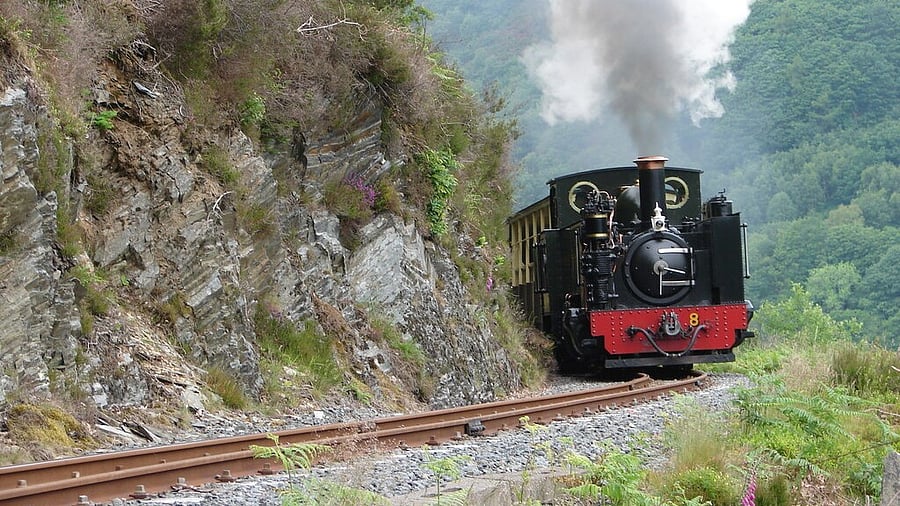
Vale of Rheidol Railway nearing the terminus at Devil's Bridge where the train negotiates the curves through Coed Ty'n-y-castell.
Credit: Wikipedia
Steam locomotives, the clickety-clack of the tracks, and the iconic “choo-choo” sound... heritage trains remain popular worldwide. France offers vintage train rides in Brittany and the Cévennes; Austria boasts the Achensee Cog Railway, which runs from Jenbach to Seespitz, passing through the culturally rich Tyrol region; Switzerland’s Brienz Rothorn Railway travels from the shores of Lake Brienz to the summit of Brienzer Rothorn Mountain; and India operates the renowned Darjeeling Himalayan Railway and the Nilgiri Mountain Railway.
However, no country has a heritage railway sector as vibrant as the UK. The UK has 173 working railways, nine operational tramways, and eight cliff railways. These old-style trains cover approximately 600 miles of track and operate across around 460 stations. A vital part of holidays, the sector preserves and brings to life a significant part of the nation’s cultural heritage. In addition to the trains, there are also 24 museums and steam centres that offer knowledge and enjoyment.
According to the Heritage Railway Association, heritage railways provide an opportunity to experience travel on “unique century-old cliff railways, rare electric or horse-drawn trams, and original Victorian or pre-war carriages hauled by historic narrow-gauge locomotives, or even famous icons like the Flying Scotsman.” Steam trains paired with stunning landscape views are a match made in heaven, and Wales offers plenty of both. The Celtic nation is home to some of the most famous “little railways” in the world, and a journey on one of these trains is the perfect way to explore the region.
The 12 “little steam railways” scattered across Wales’ breathtaking scenery include Bala Lake, Brecon Mountain, Fairbourne, Ffestiniog, Llanberis Lake, Snowdon Mountain, Talyllyn, Vale of Rheidol, Welsh Highland, Welsh Highland Heritage, Welshpool & Llanfair, and Corris. These railways are living history, with some stations styled in period décor and staff donning vintage costumes.
I took a trip on the Vale of Rheidol, travelling the 19 km from Aberystwyth to Devil’s Bridge in about an hour. The scenery, nestled in a wooded valley with jewel-like ponds, is spectacular. At Devil’s Bridge, you’ll find three bridges built hundreds of years apart, along with ample opportunities to stretch your legs, including walks to Mynach Falls, the Devil’s Punchbowl, and Jacob’s Ladder. Trains usually stop at Devil’s Bridge for an hour, but it’s possible to return on a later train if you want to enjoy a coffee at the Two Hoots Café. On the return journey, a museum located in the old engine shed at Aberystwyth station provides insight into the heritage railway’s history.
About 94 km away, Porthmadog has, over the years, become one of the world’s top steam-railway centres. Every year, around 3,00,000 visitors flock to this small town — home to just 4,000 people — on the Welsh coast to ride the Ffestiniog Railway, the world’s oldest operating railway, or its newly opened companion, the 40-km Welsh Highland Railway.
The 21.7-km Ffestiniog Railway, founded in 1832 to transport slate from the mountains near Blaenau Ffestiniog to the Porthmadog docks, offers one of the best ways to explore Snowdonia National Park. A seat in the Glaslyn, an extra-fare observation car with a large curved window at one end and plenty of comfy armchairs, offers a truly special experience. All steam railways in Wales take you through gorgeous countryside, as the land is blessed with extraordinary beauty. The vintage Brecon Mountain Railway, with its all-weather observation coaches, runs through the stunning Brecon Beacons National Park on a 10-mile round trip. The narrow-gauge Welshpool & Llanfair Railway, which links the market town of Welshpool to the rural community of Llanfair Caereinion, traverses tight curves and steep gradients on a 16-mile return journey. The Corris Railway, located between Dolgellau and Machynlleth, takes you on a 50-minute journey through the spectacular Dulas Valley. And for over 100 years, the miniature coastal Fairbourne Railway, built in 1895 to transport materials for the village’s construction, has connected Fairbourne to the sea at Barmouth Ferry via a short 2-mile journey. Wales is celebrating 2025 as the Year of Croeso (welcome), showcasing Welsh culture, language, and attractions while inviting visitors to experience the hwyl — an untranslatable Welsh word that describes “a sense of exuberance and well-being that comes from being completely engaged in an activity or moment.” Alongside this, the country is celebrating 200 years of passenger rail travel, as the UK marks the historic anniversary of modern rail.
While trains have been modernised across Wales, they still retain the charm of steam locomotives. In fact, the Bala Lake Railway recently received approval to extend its route to the centre of Bala, Gwynedd, which is expected to lead to a significant rise in passengers, from 34,000 in 2023 to an estimated 60,000 this year.
Heritage trains are a wonderful way to explore Wales. They allow you to relax and take in the scenery, offer an insight into the industries that built them, provide a snapshot of life in Wales’ past, and contribute to sustainable travel in the present. The many heritage railways also help boost local economies and preserve historic rolling stock and signalling technologies. Most importantly, they engage people with ‘living’ displays and function as working museums. So, don’t steamroll past this option — just hop aboard the heritage travel train!